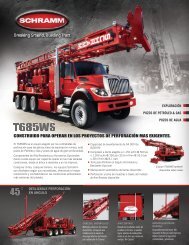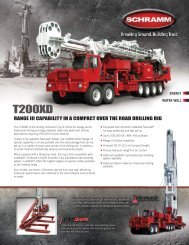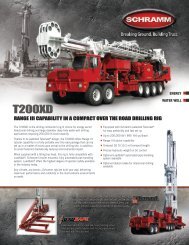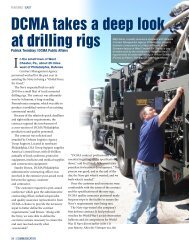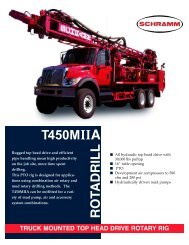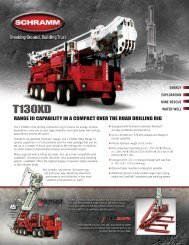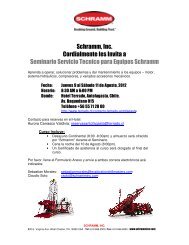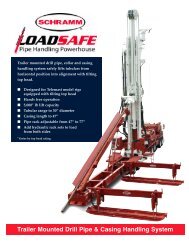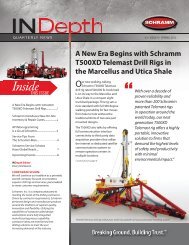Chilean Miner Rescue: The Drilling Team That ... - Schramm Inc.
Chilean Miner Rescue: The Drilling Team That ... - Schramm Inc.
Chilean Miner Rescue: The Drilling Team That ... - Schramm Inc.
You also want an ePaper? Increase the reach of your titles
YUMPU automatically turns print PDFs into web optimized ePapers that Google loves.
World Oil<br />
http://www.worldoil.com/Innovative-Thinkers-December-2010.html<br />
Page 2 of 6<br />
12/27/10<br />
As local companies began to mobilize their rigs, which were capable of drilling to about 1,400 ft, geologists<br />
began to suspect that the miners were trapped much farther down. In the days following the cave-in, Drillers<br />
Supply teamed up with local officials and drilling contractors to employ nine rigs, including four <strong>Schramm</strong><br />
T685WS reverse-circulation exploration rigs, to drill a series of pilot holes to search for the miners.<br />
“By day seven or eight, we thought we were drilling a recovery operation. We were looking for bodies,” said<br />
Hall. <strong>The</strong>n, on Aug. 22, the team got some very unexpected news. “We heard banging on the drill pipe and<br />
realized that someone was alive down there,” said Hall.<br />
One of the <strong>Schramm</strong> rigs had successfully reached the trapped miners with a 5½-in. borehole. “<strong>The</strong> miners<br />
saw [the drill pipe] and, with red paint, they wrote a message on the end of the [drillstring],” said Jeff Roten,<br />
<strong>Schramm</strong>’s service technician who stayed onsite throughout the entire operation. <strong>The</strong> message stated, simply:<br />
“All 33 of us are well inside the shelter.” Miraculously, the miners had survived 17 days with minimal supplies.<br />
In just two more days, they would have run out of food.<br />
Jeff Hart, of Layne Christensen, one of the operators of the<br />
<strong>Schramm</strong> T130XD. Photo courtesy of <strong>Schramm</strong> <strong>Inc</strong>.<br />
<strong>The</strong> news personally touched Brandon Fisher, CEO of Center Rock drilling company. Fisher, who grew up in<br />
the mining communities of southwestern Pennsylvania, initially founded Center Rock in 1998. He grew the<br />
company into a drilling product manufacturer and, in 2002, he developed a low-profile (LP) drilling series using<br />
the large-diameter drills—up to 10 ft—initially developed for bridge construction. <strong>The</strong> drills’ percussion<br />
technology proved to be especially effective in drilling through extremely hard material, such as volcanic rock<br />
infused with hard minerals.<br />
Upon hearing that the <strong>Chilean</strong> miners may not be reached until Christmas—five months after the initial mine<br />
collapse—Fisher knew he had to get involved. “It was very close to our hearts,” he said. Fisher was no<br />
stranger to mine rescue operations. In 2002, he had helped save nine miners who were trapped 270 ft<br />
underground after the Quecreek mine in southwestern Pennsylvania collapsed. As water filled the mine shaft,<br />
the rescuers drilled a ventilation hole and a second escape hole, freeing the nine miners after 72 hours.<br />
Before the San José mine collapse, there had never been a successful rescue operation at depths of 2,000 ft.<br />
<strong>The</strong> andesite rock under which the miners were trapped was highly abrasive, with a tensile strength of about<br />
39,000 psi. <strong>The</strong> team also had incomplete mine maps and knew that there were dozens of dangerous mine<br />
passages that, if affected by the vibration from the drill, could cause the mine to further cave in.



